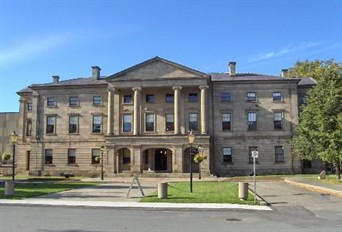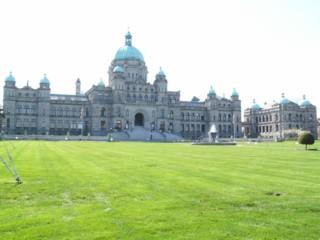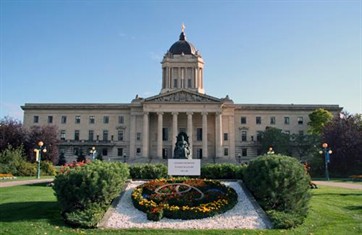Legislative Buildings: Intrigue Behind the Façade
The legislative buildings in the capital city of every province
in Canada are important symbols which represent the strength and
authority of provincial governments. These buildings are among the
most iconic in Canada because of their historic importance and
landmark visibility. Now you may be thinking that this
is going to turn into a dry lecture on history and politics, but
 in that assumption you
would be wrong! Canada's legislative buildings have some intriguing
stories behind their walls...
in that assumption you
would be wrong! Canada's legislative buildings have some intriguing
stories behind their walls...
Charlottetown, Prince Edward Island is home to one of the most
historically significant buildings in all of Canada. Built in 1847
in the Classical Revival style and reminiscent of some the great
temples of Greece and Rome, Province House was the site of the
Charlottetown Conference of 1864, the first of a series of meetings
which helped lead the Canadian colonies toward Confederation. But
did you know that the housekeeper of Province House, a woman named
Frances Preedy, lived in the basement with her family? Mrs.
Preedy's salary matched that of some members of the legislative
assembly. Now that's an attractive live-work arrangement, isn't it?

On the West Coast, in Victoria, the B.C. Legislature has some interesting
beginnings. In the early 1890s, in order to ensure that the
city of Victoria retained its position as the capital of the new
province of British Columbia, it was decided that a new, more
impressive legislative building had to be built. The architect
chosen to create this landmark was a bold choice: Francis Mawson
Rattenbury. Rattenbury arrived in Canada from Britain only a
few weeks before his design submission was chosen as the
winner. At the time of the competition, Rattenbury was only
25, and he is still considered one of the youngest architects in
Canada to design a legislative building! The structure is
constructed in the Romanesque Revival style of architecture, sits
on large manicured lawns, and was intended to introduce a formal
and impressive silhouette between the shoreline and the mountainous
backdrop. Rattenbury went on to gain considerable renown,
designing many buildings in British Columbia including that other
memorable building in Victoria, the Empress Hotel.
It is in the middle of the country, in Winnipeg, Manitoba, that
we might just find one of the most beautiful and most intriguing
legislative buildings of all. Built between 1913 and 1920 in
the Beaux Arts style, the Manitoba Legislative Building has a stunning
exterior and interior, with architectural features that are a feast
for the eyes. Probably the most visible of the ornaments is
the Golden Boy statue which graces the top of the building's
rotunda. Designed to represent youth and enterprise, it was
sculpted and cast by the artist Charles Gardet in Paris in 1918
at the Barbidienne Foundry. The  Golden Boy escaped harm
when the Barbidienne foundry was bombed at the end of the First
World War, and then, when it was placed on a French ship for
transport to Canada, it was commandeered for troops before it could
set off. It was not until after the war that the statue - which had
remained in the hold of the ship for many months - was finally
brought to Canada, transported by train to Winnipeg, and placed on
top of the legislative building.
Golden Boy escaped harm
when the Barbidienne foundry was bombed at the end of the First
World War, and then, when it was placed on a French ship for
transport to Canada, it was commandeered for troops before it could
set off. It was not until after the war that the statue - which had
remained in the hold of the ship for many months - was finally
brought to Canada, transported by train to Winnipeg, and placed on
top of the legislative building.
Perhaps less visible, but equally intriguing features of the
Manitoba Legislature are those related to the Masons, including the
number 13, which is repeated throughout the building in the bulbs
of the lamps. The number is considered a symbol of luck among
the ancient Egyptians as well as the Masons. Another unusual
design feature is something called the Pool of the Black Star, a
circular room below the rotunda with an eight-pointed black star at
its centre. It is aligned directly below the legislature's
dome as well as the Golden Boy. The room catches sounds from
all corners of the building and produces mysterious echoes when one
speaks here. In recent years, the building has gained renewed
attention thanks in part to art history professor Frank Albo who
highlights the structure's Masonic connections and mystical - if
not occult - characteristics in books and walking tours.
Canada's legislative buildings are so much more than just places
where provincial governments meet. While the county's legislatures
represent the power and authority of government in their striking
architecture, they also have other interesting stories to tell.
These buildings are symbols of our collective history, of the
tradition of parliamentary democracy, and of the hopes and dreams
of Canadians in the late 19th and early 20th
centuries who endeavoured to build a strong country.